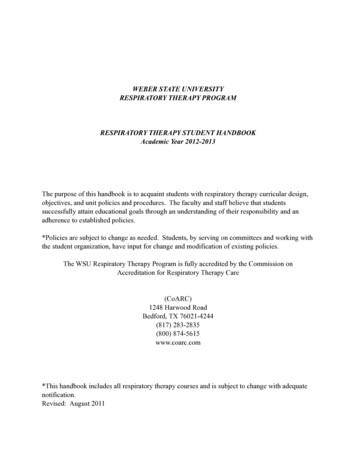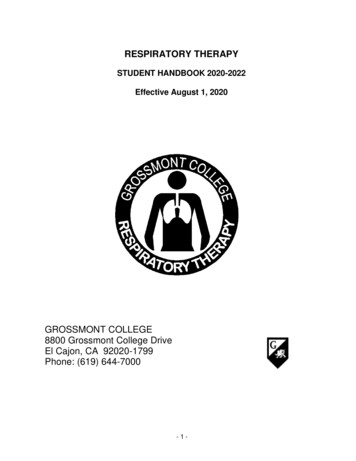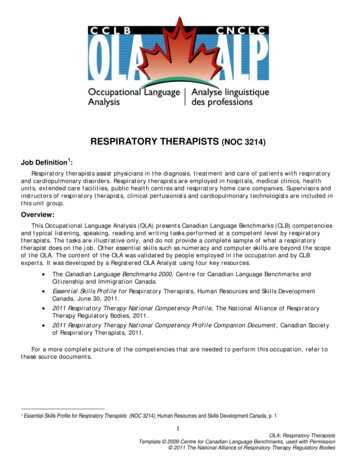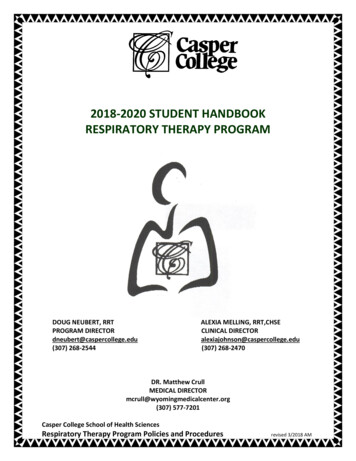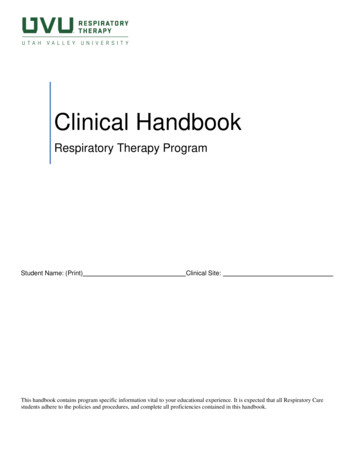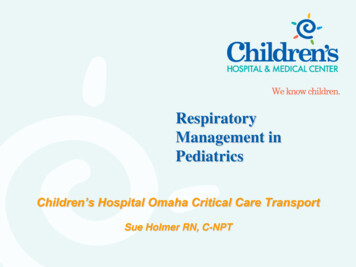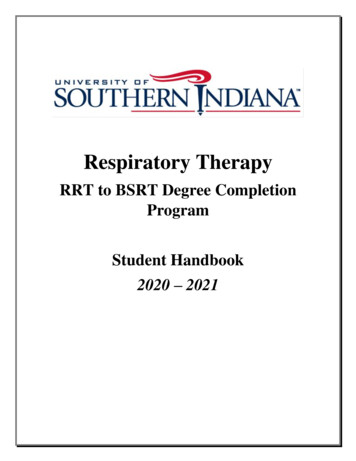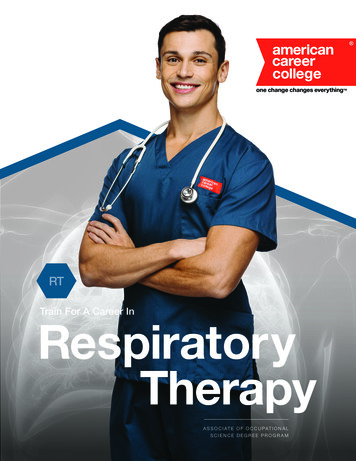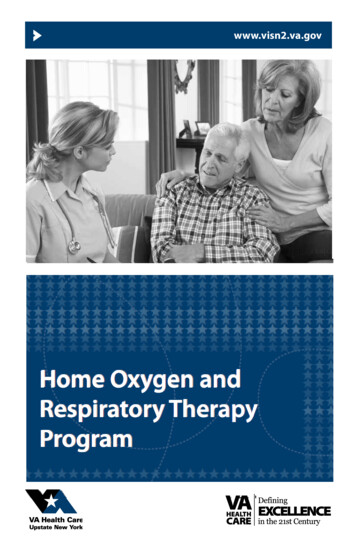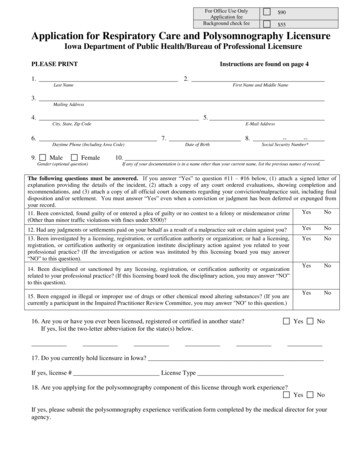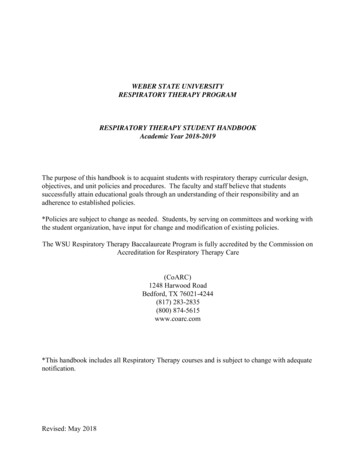
Transcription
WEBER STATE UNIVERSITYRESPIRATORY THERAPY PROGRAMRESPIRATORY THERAPY STUDENT HANDBOOKAcademic Year 2018-2019The purpose of this handbook is to acquaint students with respiratory therapy curricular design,objectives, and unit policies and procedures. The faculty and staff believe that studentssuccessfully attain educational goals through an understanding of their responsibility and anadherence to established policies.*Policies are subject to change as needed. Students, by serving on committees and working withthe student organization, have input for change and modification of existing policies.The WSU Respiratory Therapy Baccalaureate Program is fully accredited by the Commission onAccreditation for Respiratory Therapy Care(CoARC)1248 Harwood RoadBedford, TX 76021-4244(817) 283-2835(800) 874-5615www.coarc.com*This handbook includes all Respiratory Therapy courses and is subject to change with adequatenotification.Revised: May 2018
TABLE OF CONTENTSSECTION I - MISSION STATEMENT AND PHILOSOPHYPROGRAM OUTCOMESSECTION II - RESPIRATORY THERAPY PROGRAM CURRICULUM FRAMEWORK AND MODELCURRICULUM - CONCEPTUAL MODELSECTION III - RESPIRATORY THERAPY COMPETENCIESROLE AS AN APPLIED ASSOCIATE RESPIRATORY THERAPY CRT:ROLE AS A MANAGER OF CARE:PROFESSIONAL ROLE DEVELOPMENT:ROLE AS AN AAS DEGREE RESPIRATORY THERAPIST GRADUATE:ROLE AS A BACCALAUREATE RESPIRATORY THERAPIST GRADUATE:PROFESSIONAL ROLE DEVELOPMENT:SECTION IV - RESPIRATORY THERAPY PROGRAM EXPECTATIONSFUNCTIONAL REQUIREMENTS FOR STUDENT SUCCESSSTUDY EXPECTATIONSEXTERNAL WORK EXPECTATIONSWRITTEN WORK EXPECTATIONSGRADE EXPECTATIONSTHE "A" STUDENT - AN OUTSTANDING STUDENTTHE "B" STUDENT - AN ABOVE-AVERAGE STUDENTGRADESPROGRAM PROGRESSION & COMPLETIONTERMINATION/WITHDRAWAL/READMISSION TO THE RESPIRATORY THERAPY PROGRAMPROFESSIONAL APPEARANCE/UNIFORMSSECTION V - RESPIRATORY THERAPY PROGRAM POLICIES AND PROCEDURESDISABILITY STATEMENTREGISTRATIONATTENDANCE AND ABSENTEEISMRESPIRATORY THERAPY POLICIESRESPIRATORY THERAPY DEPARTMENT STUDENT DRUG SCREEN POLICYRESPIRATORY THERAPY DEPARTMENT STUDENT CRIMINAL BACKGROUND CHECK POLICYSECTION VI - STUDENT RECORDS, DOCUMENTATION, ADVISEMENT, GRADUATIONMAINTENANCE OF STUDENT RECORDSSTUDENT DOCUMENTATION OR ENTRANCE PORTFOLIOHEALTH INSURANCE, HEPATITIS B VACCINE, TITER, PREGNANCY, AND OSHA REGULATIONSBASIC LIFE SUPPORT - CLASS C (HEALTH CARE PROVIDER)STUDENT ADVISEMENT AND COUNSELINGGRADUATION PROCEDURESPROCEDURES FOR GRADUATION: SECTION VII - PROCEDURES FOR LICENSUREOBTAINING UTAH LICENSURE FOR PRACTICESECTION VIII - STUDENT REPRESENTATION(S)Revised: May 20182
STUDENT ORGANIZATIONS AND ACTIVITIESSECTION IX - RESPIRATORY THERAPY PROGRAM POLICIES & PROCEDURES RELATED TOUNSATISFACTORY STUDENT PERFORMANCEWSU DISCRIMINATION AND HARASSMENT POLICY (PPM 3-32)ACADEMIC INTEGRITY EXPECTATIONSDUMKE COLLEGE OF HEALTH PROFESSIONS (DCHP) CHEATING POLICYRESPIRATORY THERAPY PROGRAM & INSTITUTIONAL SANCTIONS ASSOCIATED WITHUNSATISFACTORY STUDENT BEHAVIORSTUDENT INCIDENT REPORTSMISCONDUCT LEAVE OF ABSENCE/EXPULSIONWEBER STATE UNIVERSITY STUDENT DUE PROCESS POLICY(PPM 6-23 thru 6-33)Student Incident ReportStudent Academic Performance Warning or ContractStudent Behavioral Performance Warning or ContractSECTION X - PROGRAM RESOURCES FOR STUDENT SUPPORTSTUDENT RESOURCESOGDEN CAMPUSFINANCIAL AID/SCHOLARSHIPSSECTION XI WSU RESPIRATORY THERAPY PROGRAM INFORMATIONCLINICAL ATTENDANCE AND SCHEDULINGClinical TardinessClinical AbsencesLABORATORY PRACTICE POLICIESSUPPLIES AND TEXTSPROFESSIONAL ORGANIZATIONSSELECTION INTO THE BS RESPIRATORY THERAPIST PROGRAMPROGRAM COMPLETION REQUIREMENTSAGREEMENTBACKGROUND CHECK AGREEMENTARTERIAL BLOOD GAS PUNCTURE CONSENTRevised: May 20183
SECTION I - MISSION STATEMENT AND PHILOSOPHYThe mission of WSU Department of Respiratory Therapy is to prepare graduates for the practiceof Respiratory Therapy in a variety of healthcare settings. We offer career mobility through anarticulated ladder approach to Respiratory Therapy education. WSU Respiratory Therapyfaculty provides Respiratory Therapy education to a diverse population of students residing inurban and rural areas, building a foundation for lifelong personal and professional learning.As an integral part of Weber State University and the Dumke College of Health Professions,Respiratory Therapy faculty assumes responsibility for maintaining broad university and collegemissions and objectives which include: teaching, community service, and leadershipdevelopment in education, administration, and research. Changing needs of society requirevarying patterns of practice and delivery of health services occurring in a variety of health careenvironments. A respiratory therapist must be sensitive to these changing social needs.Therefore, faculty believe in the value of integrating general education (basic to citizenship andpersonal growth) in a program promoting educational mobility through three separate, butcoordinated, units of study. Education affords opportunity for individuals to develop in social,cultural, professional, and personal roles.The Respiratory Therapy faculty has identified the following concepts as being pertinent to themission/philosophy statements. These concepts are defined as: individuals, society, respiratorytherapy, respiratory therapy education, and teaching/learning.Individuals: Unique biological, thinking, and feeling beings. An individual cannot befragmented into separate parts. An individual interacts holistically with the environment, andstrives for balance and a sense of well being within personal and societal contexts. Individualshave the right and responsibility to make choices.Society: Composed of dynamic and interactive systems involving individuals, families, groups,and communities. These systems interact to fulfill perceived needs. These needs are influencedby variables such as learned behaviors and cultural expectations. Respiratory therapists recognizeand respect the human differences and diversity of populations within society.Respiratory Therapy: An art and a science concerned with promoting and restoring health,rehabilitation, and support to the dying. Respiratory therapists provide care throughout thelife-span. Respiratory therapists assess, diagnose, manage, and evaluate human responses toactual or potential health problems within a caring context. A holistic respiratory therapyperspective is enhanced by recognition of environmental factors and human needs. The use ofskilled communication facilitates all aspects of holistic respiratory therapy care. All respiratorytherapists are responsible and accountable for maintaining safe and effective respiratory therapycare within their scope of practice.Revised: May 20184
Respiratory Therapy Education: A lifelong process which promotes the development ofknowledge, skills, and personal values. The process empowers learners to reach their fullestpotential. Respiratory therapy education is based upon knowledge derived from liberal arts,respiratory therapy science, and social, biological, and physical sciences. Respiratory therapyeducation is concerned with helping individuals to understand and utilize the respiratory therapyprocess, and to incorporate standards of professional respiratory therapy practice. Through aprocess of self realization, adults assimilate and synthesize knowledge, cultivate critical thinkingabilities, become adept with technical skills, develop respiratory therapy care strategies based onstandards of care, evolve personal potential, and establish values.Teaching/Learning: Faculty utilizes teaching and learning theories to organize and evaluatelearning situations. Faculty believes learning is an inherent process which fosters the acquisitionof knowledge, understanding, and skills. Higher-order learning can be facilitated when anindividual gains a picture of the whole, assimilates the content, and integrates the information bycomparison to past or recent experience. Faculty recognizes the need for individuals to developthe skills of creative/critical thinking for higher-order learning to occur.Teaching is the process of providing guidance for learning. Teachers are given the charge offacilitating a student's natural ability to learn. Teachers use various models, theories andstrategies for providing learning experiences. The use of a variety of teaching strategies,combined with the diversity of faculty members, enhances student learning. Learning takesplace more readily in an accepting and stimulating environment where students are free toexpress themselves. Sharing of ideas and experiences between faculty and students facilitateslearning and encourages quality of student/faculty interaction. As facilitator and consultants forlearning, faculties view each learner as unique.Education: Learning is an integral part of life and a continuous process. Weber StateUniversity respiratory therapy faculty support educational mobility through three separate, butcoordinated, units of study. The respiratory therapy faculty recognizes common foundations andareas of achievement for all respiratory therapists. An orderly progression from certifiedrespiratory therapist to registered respiratory therapist is possible by building on respiratorytherapy competencies at each preceding level. Education based on specific competencies at eachlevel of respiratory therapy leads to measurable outcomes and will result in graduates who havethe ability to function within an appropriate scope of practice.Revised: May 20185
PROGRAM OUTCOMESProgram outcomes are developed as performance indicators which give evidence that the WSURespiratory Therapy Program is meeting the mission and goals set by faculty. Documentation ofoutcomes shows the effectiveness of the educational program and serves to guide maintenanceand revision of components of the program. Program outcomes have been developed using theCommission on Accreditation for Respiratory Therapy Care criteria as guidelines. Outcomes areconsistent with the mission and philosophy of WSU, Dumke CHP, and the Respiratory Therapyprogram. At the completion of their program of learning the graduate will:OUTCOME #1:Students will progress to graduation in a timely manner as identified byprogram policy. Graduates will be educated to be respiratory therapistswho are prepared to be employed in diverse health care setting at theappropriate level of education: CRT and RRT.OUTCOME #2:Students will successfully pass the National Board for RespiratoryTherapy CRT and RRT certifications established benchmark pass rate.OUTCOME #3:AAS and BS program graduates, seeking such employment, will beemployed in a health care setting within 6 months of graduation.OUTCOME #4:Students and graduates will be satisfied that the program of learningprovides qualified faculty; adequate resources to meet educationalmission; adequate clinical facilities to provide sufficient learningexperiences; and the means to increase student skills in critical/creativethinking, communication, and therapeutic respiratory therapyinterventions. Employers will be satisfied that the program of learningAAS level and BS level graduates to practice respiratory therapy at theappropriate level of preparation following graduation.SECTION II - RESPIRATORY THERAPY PROGRAM CURRICULUMFRAMEWORK AND MODELThe curriculum model is a schematic representation which describes the concepts, beliefs andphilosophy upon which the curriculum is organized and developed. The model serves as a guidefor curriculum development and decision-making by faculty and as a resource to clarify anddirect learning by students. The model illustrates the following central components of thecurriculum framework.Learners and educators interact in a process whereby students gain competency needed tofunction within their appropriate scope of respiratory therapy practice . The curriculumencourages a holistic view of the patient and fosters the learner's socialization into the health caresystem. Learner, educator and respiratory therapy practice are represented by intersectingRevised: May 20186
circles. The intersecting area represents respiratory therapy practice developed by each learnerthrough the teaching-learning process.The overall goal or purpose of the curriculum is to prepare the learner (student) to practice the artand science of respiratory therapy. To accomplish this goal, faculty and students interact witheach other in a purposeful, goal directed manner as dictated by the curriculum. Both the learnerand the educator have distinct and separate responsibilities in this teaching-learning process.The educator is a facilitator who promotes, directs and evaluates learning and the learner. Theeducator must be knowledgeable and competent in the practice of respiratory therapy and mustbe caring and committed to the goals of the learner and the curriculum.The learner is a consumer of information but is responsible for his/her own learning, both inquality and quantity. As a consumer, the learner shares, evaluates and applies information as isappropriate. The learner, by seeking admission into the Weber State University RespiratoryTherapy Program, accepts the responsibility of understanding and meeting curriculum goals andexpectations. It is the responsibility of the learner to seek help when academic goals are not met.The practice of respiratory therapy is dynamic, multi-faceted and flexible in order to beresponsive to the needs of patients: it is therefore subject to reform and change when appropriate.Provider of Care includes competence in therapeutic respiratory therapy interventions that arethe substance of respiratory therapy practice.Cognitive competence involves a sound base of theoretical knowledge, including that whichis research based, and the ability to apply that knowledge to clinical practice. Cognitivecompetence guides judgments or evaluations and utilizes creative critical thinking, especiallywhen confronting more complex problems. Creative critical thinking is higher ordered thinkingcharacterized by openness of inquiry, ability to ask pertinent questions, production of new ideas,flexible problem solving, examination of underlying assumptions and the ability to presentdiverse perspectives.Technical competence is demonstrated by the ability to use equipment and supplies withconfidence and skill, thus meeting patient needs with minimal distress. It also includes theability to adapt procedures and equipment to meet patient needs in diverse situations and caresettings. Technical competence requires study, practice and clinical experience to perform oftencomplex tasks proficiently.Interpersonal competence is the ability to apply concepts of communication and therapeuticinteraction in building and maintaining relationships with patients, families and other membersof the health care team. It promotes the significance of each individual, including their strengthsand abilities, to achieve established goals. Interpersonal competence is dependent upon caring.Revised: May 20187
Ethical and legal competence is a framework of conduct which guides the practice ofrespiratory therapy. It revolves around ethical and moral behaviors, both professional andpersonal, which promote the interest of patients, families and communities. It adheres toestablished professional codes of ethical behavior and promotes the advocacy of patients. Legalcompetence includes behaviors which promote adherence to established standards, awareness ofpotential liability and actions which reduce the risk of litigation.Manager of Care pertains to responsibility and accountability to the patient and workenvironment through a sound work ethic. Personal management is demonstrated throughattendance, work within job description, performance of assigned responsibilities, effective useof time, management of conflict, team work and commitment to the vision and values of thehealth care organization. People management includes delegation, evaluation, conflict resolutionand collaboration with other members of the health care team as respected and reliablecolleagues to assure achievement of patient goals. Organization and direction of respiratorytherapy care involves implementation of strategies to assure highest quality of patient care and asafe workplace. This involves incorporation into the patient care environment of currentresearch findings in patient care, established standards of practice, institutional policies andprocedures, scope of practice of the healthcare team and workplace laws and rules.Professional Role Development encompasses preparation in the discipline and identification ofthe unique roles of the different levels of undergraduate respiratory therapy practice. It isdemonstrated through commitment to the vision and values of the profession of respiratorytherapy. Central to professional role development is an understanding of leadership, power, theprocess of empowerment and issues integral to being a member of the discipline of respiratorytherapy.Revised: May 20188
CURRICULUM - CONCEPTUAL MODELThe conceptual framework of the curriculum is based on concepts which include: respiratorytherapy care processes ; human needs across the lifespan; caring; health care continuum .Foundational concepts are intertwined within each of the threads of the practice of respiratorytherapy. The large blocks at the base of the model represent these concepts.Respiratory Therapy Care Processes involve the methodology of decision making that givedirection and order to respiratory therapy care. The traditional components of the respiratorytherapy process include patient assessment, diagnosis, planning/implementation and evaluation .They include patient and family in planning and providing therapeutic respiratory therapyinterventions. Respiratory therapy care processes also involve interdisciplinary plans of care thatpromote consistency and provide optimal timing and sequencing of interventions for patients.Such plans conserve resources and time while maximizing the quality of patient care.Human Needs Across the Lifespan encompasses the diverse elements required by eachindividual including a safe, effective care environment, physiological integrity, psychosocialintegrity and health promotion and maintenance. Human needs are recognized as changingacross the lifespan. Information and experiences that integrate developmental milestones andhealth risks over the lifespan are included throughout the curriculum. Human needs are themotivating factors for all human behaviors. A safe, effective care environment embraces theneed for environmental and personal safety, right to confidentiality, respect for cultural andreligious differences and a right to continuity of care.Caring is the recognition and acknowledgment of the value of individuals, families andcommunities. Caring is an altruistic philosophy of moral and ethical commitment toward theprotection, promotion and preservation of human dignity and diversity. Caring does not happenby chance but can and must be learned and practiced. It is an intentionally focused process basedon the inherent worth of people. Caring is expressed through competence. Caring is identifiedby behaviors that advocate for patients, foster trust and ensure actions that promote the patient'swell being.Health Care Continuum identifies the unique practice areas of health promotion, restoration ofhealth and rehabilitation. Health promotion consists of respiratory therapy interventionsdesigned to support the vitality of individuals, families and communities. Primarily, respiratorytherapist are involved in strengthening and promoting active strategies to assist others inattaining and maintaining personal, social, cultural and environmental well-being. Restoration ofhealth involves activities that are designed to recognize early signs and symptoms of impairedwell-being and remove causative factors. Interventions are focused on the treatment of disordersand prevention of complications. Rehabilitation is focused on promoting optimal function ofindividuals, families and communities despite disability or dysfunction.Revised: May 20189
SECTION III - RESPIRATORY THERAPY COMPETENCIESROLE AS AN APPLIED ASSOCIATE RESPIRATORY THERAPY CRT:Demonstrates cognitive competence by assuming responsibility for own learning, by applyingtheoretical knowledge to clinical practice and by applying concepts of beginning or basicproblem solving to clinical decision making.Demonstrates technical competence through the appropriate, skillful use of basic equipment toprovide interventions and/or therapies according to established standards.Demonstrates interpersonal competences through interactions and/or relationships thatpromote achievement of goals yet affirm the worth of all individuals involved. In addition,demonstrates interpersonal competence through the use of caring behaviors including verbalcommunication, non-verbal communication, look and touch that conveys respect, acceptance,trust, shares information, and provides mutual enrichment.Demonstrates ethical and legal competencies by functioning according to the professionalcode of ethical behavior and individual personal moral code: such codes ensure accountabilityfor personal practice, patient advocacy, confidentiality and the use of legal safeguards.ROLE AS A MANAGER OF CARE:Demonstrates personal management skills by planning and by utilizing time appropriately andby acting efficiently and in a goal directed manner. With guidance as needed, establishespriorities for managing patient care.Demonstrates responsibility and accountability to the workplace by meeting schedules andshift assignments, by promoting cost containment, by awareness of potential safety and/or legalproblems, and by reporting or intervening to alleviate problems when possible. Works as amember of the health care team by helping others to provide care when necessary and by actionswhich promote the goal of the health care setting rather than only personal goals.PROFESSIONAL ROLE DEVELOPMENT:Understands and complies with the Scope of Practice as outlined in the Respiratory TherapistPractice Act of the state in which licensed.Adheres to the AARC Respiratory Therapy Code of Ethics.Understands and functions within the role of the licensed respiratory care practitioner in varioushealth care settings.Revised: May 201810
Assumes responsibility for personal improvement by identifying strengths and weaknesses andseeks education and/or help as needed.Assumes responsibility for professional growth and improvement by identifying educationalopportunities and consideration of career mobility.Understands and supports the purpose and the goals of professional organizations.Works to promote respiratory therapy and health care through political, economic, and societalactivities.ROLE AS AN AAS DEGREE RESPIRATORY THERAPY GRADUATE:Demonstrates cognitive competence through the use of creative/critical thinking in solvingclinical problems and making clinical decisions. Is able to consider alternatives. Utilizesknowledge gained from reading basic research reports, journals and attending workshops toelevate personal respiratory therapy practice.Demonstrates technical competence through the skillful use of complex equipment andprocedures to provide care for acutely ill patients.Demonstrates interpersonal competence through the use of therapeutic communication skillsand caring behaviors to provide respiratory therapy care to complex, difficult patient problemsand/or situations.Demonstrates ethical and legal competencies by being self-motivated in ensuring ethical/legalpractice and by teaching and/or evaluating ethical/legal standards to other respiratory therapypersonnel. Works to resolve ethical problems encountered in practice.ROLE AS A BACCALAUREATE RESPIRATORY THERAPY GRADUATE:Demonstrates Personal Management Skills by utilizing principles of time management whenplanning and setting priorities for respiratory therapy care for patients, and by ensuringcontinuity of care within the employing institution. Uses constructive criticism and suggestionsfor improving respiratory therapy practice.Demonstrates Responsibility and Accountability by delegating care to other workerscommensurate with their educational preparation/ability, by being accountable for their actionsand by reporting concerns regarding quality of care to the appropriate person.Demonstrates People Management Skills by evaluation of other workers, including theirpersonal and professional actions and abilities, and by encouraging/promoting excellence inco-workers.Revised: May 201811
PROFESSIONAL ROLE DEVELOPMENT:Values professional respiratory therapy as a career and values own practice.Understands and functions within the role of the respiratory care practitioner in various healthcare settings.Participates in research programs when possible and actively promotes the use of research inrespiratory therapy care.Serves as a role model regarding health to patients, families, communities, and peers.Understands values and promotes the concept of the professional role of respiratory therapy.SECTION IV - RESPIRATORY THERAPY PROGRAM EXPECTATIONSPROGRAM EXPECTATION RELATIVE TO PROFESSIONAL COMMUNICATIONWITHIN THE CLINICAL SETTINGThe Respiratory Therapy student is expected to acknowledge and comply with the administrativeauthority of the assigned clinical faculty while practicing in the clinical setting. Students areexpected to comply immediately, without dispute, with all clinical faculty and/or on-dutyrespiratory care practitioner instructions related to patient care.If conflict does occur, the student and faculty will approach the conflict and communicateeffectively on a professional level. This performance expectation includes to communicationwith patients, peers, Respiratory Therapy department staff, and other members of the healthcareteam.FUNCTIONAL REQUIREMENTS FOR STUDENT SUCCESSWeber State's Respiratory Therapy Program values diversity in the students who wish to enterthe profession of Respiratory Therapy. Students interested in entering the Respiratory Therapyprogram must be aware of functional requirements, environmental factors, and psychosocialdemands that must be met to be considered as a candidate for the Respiratory Therapyprofession.1.Functional requirements include, but are not limited to:a.Must be able to independently push, pull, and lift a medically fragile adult whenpositioning or transferring.Revised: May 201812
b.c.d.e.f.g.h.i.Must have the ability to palpate body structures and be able to differentiate andreport subtle variations in temperature, consistency, texture and structure.Must be able to identify and distinguish subtle variations in body sounds such asbreathing.Must be able to read, understand, and apply printed material which may includeinstructions printed on medical devices, equipment and supplies.Must be able to visually distinguish subtle diagnostic variations in physicalappearance of persons served. An example would be "pale color".Must be able to distinguish subtle olfactory changes in physical characteristics ofpersons served.Must be able to walk and stand for extended periods of time.Must possess the ability to simultaneously and rapidly coordinate mental andmuscular coordination when performing respiratory therapy tasks.Must be able to effectively communicate in English, in both written & verbalformat.2.Environmental factors include:a.Protracted or irregular hours of work.b.Ability to work in confined and/or crowded spaces.c.Ability to work independently as well as with coordinated teams.d.Potential exposure to harmful substances and/or hazards.3.Psycho social demands include:a.Ability to maintain emotional stability during periods of high stress.b.Ability to work in an emotionally charged or stressful environment.CLINICAL CONDUCT EXPECTATION RELATED TO STUDENT PRACTICE OFRESPIRATORY THERAPYRespiratory Therapy behavior (acts, knowledge, and practices) which fails to conform toaccepted standards of the Respiratory Therapy profession and which could jeopardize thehealth and welfare of people constitutes unprofessional conduct and is subject toRespiratory Therapy Program policies/procedures related to unsatisfactory studentbehavior.Such behaviors include but are not limited to the following:1.failure to safeguard a patient's right to privacy as to the patient's person, condition,diagnosis, personal effects, or any other matter about which the licensee is privileged toknow because of the licensee's position or practice as a respiratory therapist;2.failure to provide respiratory therapy service in a manner that demonstrates respect forthe patient's human dignity and unique personal character and needs without regard to theRevised: May 201813
patient's race, religion, ethnic background, socioeconomic status, age, sex, or the natureof the patient's health problem;3.engaging in sexual relations with a patient during any:a. period when a generally recognized professional relationship exists between therespiratory therapist and patient; orb. extended period when a patient has reasonable cause to believe a professionalrelationship exists between the respiratory therapist and patient;4.exploitation of the patienta. a licensee exploiting or using information about a patient or exploiting thelicensee's professional relationship between the licensee and the patient;b. exploiting the patient by use of the licensee's knowledge of the patient obtainedwhile acting as a respiratory therapist;5.unlawfully obtaining, possessing, or using any prescription drug or illicit drug;6.unauthorized taking or personal use of respiratory therapy supplies from anemployer;7.unauthorized taking or personal use of a patient's personal property;8.9.knowingly entering into any medical record any false or misleading informationor altering a med
The Respiratory Therapy faculty has identified the following concepts as being pertinent to the mission/philosophy statements. These concepts are defined as: individuals, society, respiratory therapy, respiratory therapy education, and teaching/learning. I n di v i d u a l s: Unique biological, thinking, and feeling beings.
